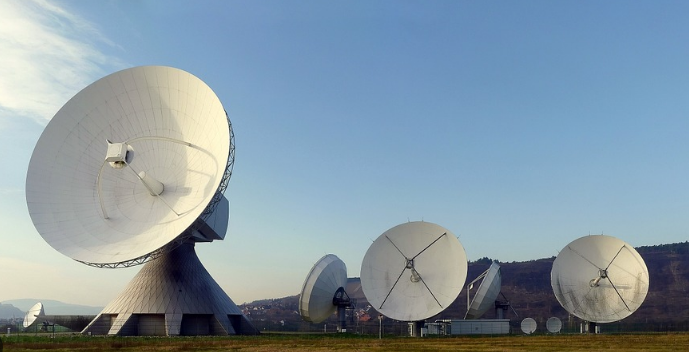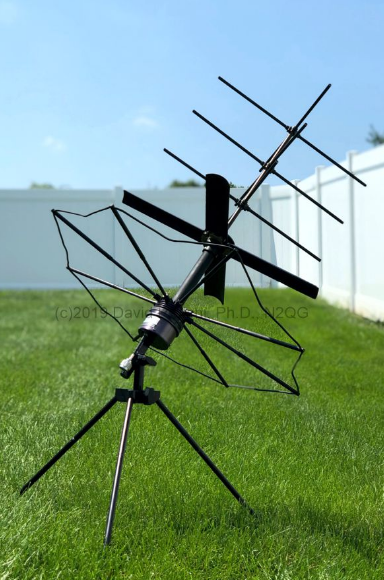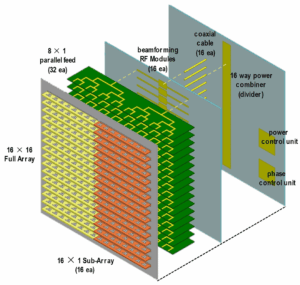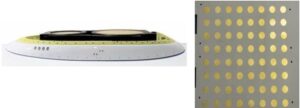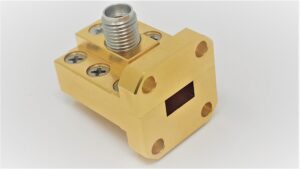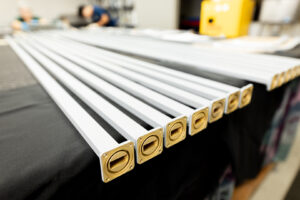Table of Contents
Parabolic Reflectors
Parabolic reflectors are one of the most important components of satellite communications, mainly because they allow focusing radio waves into a narrow beam. These antennas use an appropriately shaped rounded reflective surface to guide the electromagnetic waves emitted. The design ensures that the signals falling onto the reflector in a parallel to its main axis fashion clump together and follow the same path, allowing for their concentration.
Features of Such Reflectors
-
These antennas usually have a high degree of gain, meaning they can transmit or receive signals at larger distances. Such gain may be as high as 40 dB or more for a parabolic dish that has a radius of 3 meters and operates in the C-band . Find more information in our example of a Universal Instruments Corporation essay.
-
It has a narrow beam, so it is easy to direct it at the satellite. For example, a 2-meter dish at 4GHz may have a beam width of around 1.5 degrees.
-
Their efficiency is high, meaning that the great majority of the energy consumed by the device is directed at the desired target. This measure usually depends on the quality of the surface shape and material – it may be as high as 70% or even higher.
-
Features of Material and Costs
The material reflects the extreme conditions in which reflectors have to be used, such as the space environment with extreme temperatures and radiation. Therefore, it is usually made of aluminum, which is heavy but very sturdy. The costs of such a structure are usually within the bounds of $5000 to $10000 for a normal 3-meter dish. Its construction requires the building to be aimed very precisely at the satellite, in question, since the beam width is usually about 1-2 degrees.
Maintenance
The maintenance is relatively simple: it only requires keeping the surface undamaged and maintaining its shape.
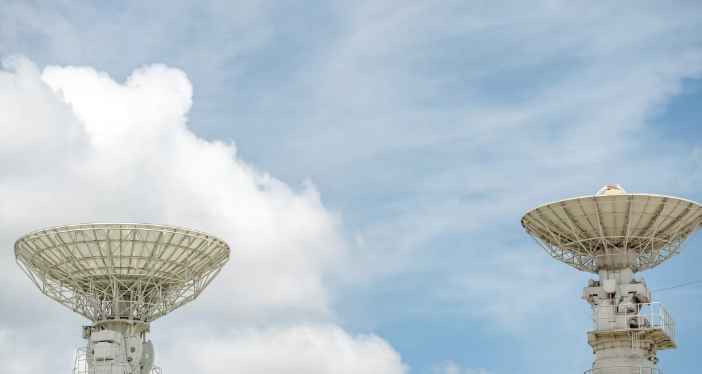
Horn Antennas
Horn antennas are one of the oldest types of antennas having quite a simple design. They consist of a flaring metal waveguide, which is called a horn, that gradually expands and directs radio waves into a beam. This type of antenna is widely used in satellite communications as it can provide moderate gain and wide bandwidth. The key benefits of horn antennas are their simple design and the ability to work over a wide frequency range. Some of the characteristics of horn antennas include:
-
Broadband performance. It refers to the ability to operate at variable but high quality levels throughout a wide frequency range. Thus, the horn antenna can operate at frequencies from 2 GHz to 40 GHz.
-
Moderate gain. Typically, it ranges from 10 to 25 dB, which is much less than that of large parabolic antennas but is often sufficient for practical applications.
-
Beamwidth. Horn antennas can guide both as a columnated mode and in radiating mode, depending on their size and manufacture. The beamwidth for the relatively small horn antennas can be approximately 20 to 50 degrees.
One of the key points defining the performance of such antennas is the material used for construction. The material should minimize signal absorption, be stable, and strong. The most common materials used for these antennas are copper and aluminum, which have a fairly good performance-to-weight ratio. In total, a horn antenna with a standard size costs about $300-1500, which is significantly lower than larger parabolic antennas. Another advantage of this type of antenna is relatively high efficiency at about 60% to 80%. In addition, horn antennas can be easily installed due to the lack of moving parts and the robust design, which is why they can be used in both stationary ground and spacecraft applications.
Phased Array Antennas
Phased array systems are the most advanced antenna technology until now. It is particularly useful in satellite communications and space system applications. Phased arrays consist of an array of small antennas, or elements, that can be electronically turned to point their beam at a different direction without moving the entire structure. When used in satellite communication applications, rapid beam repositioning improves communication efficiency. Overall, the most important benefits of phased array antennas include beam steering, high gain, or directivity, and frequency agility.
Beam steering is an outstanding benefit of phased array systems. Phased arrays can move their beam within milliseconds, which represents a significant improvement compared to mechanical steering systems. For instance, an array of 500 elements allows finding the target satellites very quickly and forming a high gain beam on it. Directivity and high gain are also essential aspects of these antennas. The gain of a phased array is obtained by combining the signals from the elements of the array. For instance, an array of 500 elements can provide a gain of approximately 30 dB. While in terms of a directivity of least 500 times, the gain is only 27 dB.
Frequency agility is another feature of phased arrays. Such antennas can operate over a wide frequency range from 1 to 50 GHz and even higher. This is extremely important for space system and satellite communication applications, because frequency spectrum allocation is a significant issue in modern communications.
One of the significant disadvantages of phased array antennas is the overall complexity of the electronic systems used. The electronic control system includes such important components as phase shifters, amplifiers, and digital signal processors . This makes these antennas more expensive compared to the traditional systems. Building a small phased array system with 300 elements could cost from $10,000 to $100,000. The higher cost is achieved with a higher number of elements in the array and the higher complexity of the electronic control systems. On the other side, the higher performance of phased arrays justifies the higher cost. The efficiency of phased array systems highly depends on the electronic components, and performance efficiency usually varies from 50% to 70%.
Factors Affecting Antenna Performance
Most critical factors affect antenna performance in satellite communications. Understanding these factors can help improve communication systems’ design and implementation. Major factors include the frequency range, gain, directivity, and polarization properties. The frequency range is composed of various frequencies at which an antenna is designed to function. Each frequency requires a specific antenna design to handle the specific propagation characteristics. For example, the 2.4 GHz frequency, which is commonly used in satellite communications . To overcome the atmospheric conditions, these antennas must have a design that allows the beam to propagate through and not lose the signal strength. In the higher frequency band of Ka-band from 26.5 GHz to 40 GHz, as defined by the International Telecommunications Union , the antennas and materials must be able to handle higher losses from rain fade.
Gain and directivity
Gain is the measure of concentrative reaching power of an antenna. It specifies the focus of energy by the antenna in a certain direction. When using a higher gain antenna, the power is more focused to a specific point increasing the distance that signals can be transmitted or received . Gain is mainly used in reference to the gain in one direction. In satellite communication, smaller dishes have gains of up to 20 dB and larger 3-4 m dishes sometimes as high as 50 dB . The gain in terms of a directional beam of the antenna is related to directivity, which defines an antenna’s gain under the best conditions if its energy was concentrated in only one direction. Directivity is an essential property in communication to help focus the energy transmitted by the antenna over long distances to ensure the signals are effectively received from the satellites.
Polarization properties
Polarization is the orientation of the radio wave in terms of the electric field produced by the antennas. The available polarizations are either linear, horizontal or vertical, or circular, left-hand circular or right-hand circular . Most satellite communication systems use linear polarization, and some use circular polarization. Large misalignments between the polarization of the receive and transmit antennas cause major losses of up to 30 dB. Matching the polarization of the receive and the transmit antenna is therefore critical to improve the efficiency. The left-hand circular receive antenna, for example, would experience 20 dB loss when mistakenly receiving signals from a right-hand circular transmit antenna.
Material and construction quality
The materials used to construct an antenna have a significant impact on its performance. Most outdoor antenna structures are made of highly resistive materials such as aluminum that do not rust and are relatively light in weight. The quality of the construction also plays a major role in how the antenna can keep its shape even in high-speed winds that place the structures under high pressure. The balance between the resistance and the quality of strength is the main factor to focus on during the construction to give a good performance of the antenna.
Installation considerations
Proper alignment is also considered to be a key design consideration. Installation and proper alignment of the antenna systems play a major role in their overall performance. A few degrees of misalignment can have a huge impact on the performance of the satellite television or communication.

